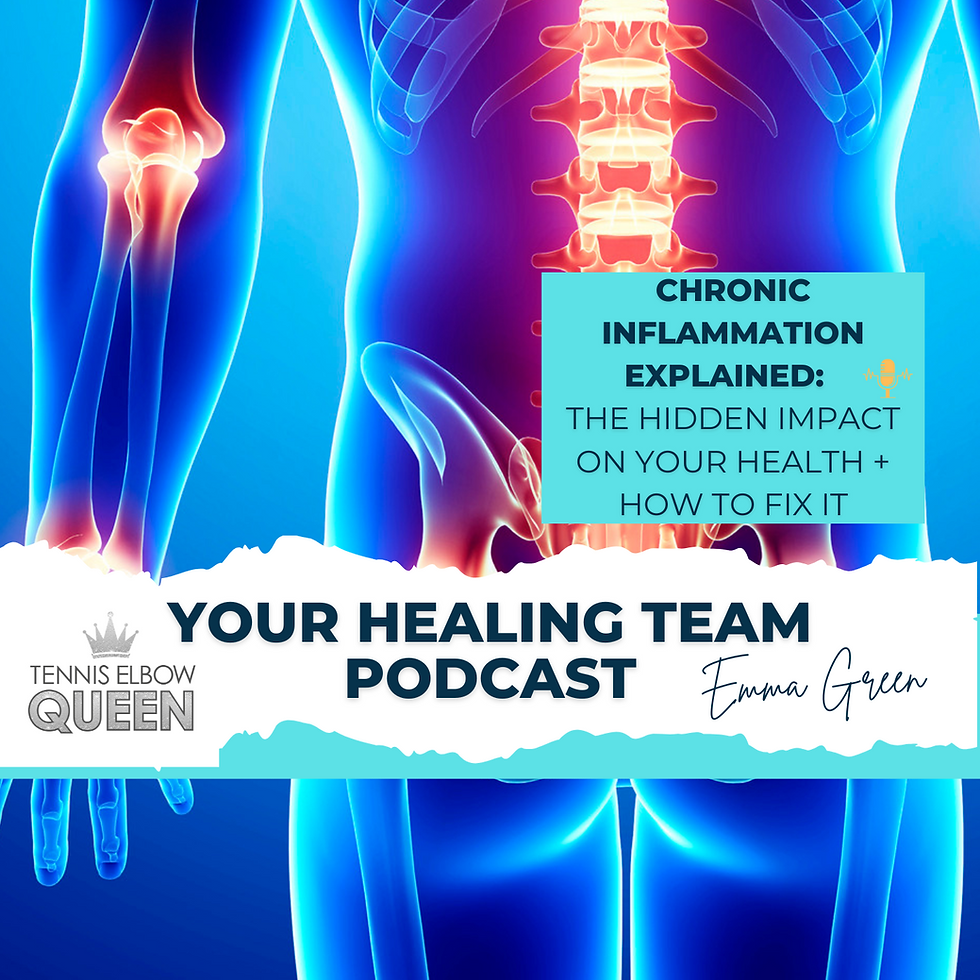What is Tennis Elbow (Lateral Epicondylitis)?
- emmagreenpt
- Sep 12, 2022
- 4 min read
What is tennis elbow, also known as lateral epicondylitis? Tennis elbow is a tendon problem. So let's back up a little bit - what is a tendon? A tendon is a connective tissue that basically attaches the muscles to the bones. That's all the tendon is, it's connective tissue.
When we're talking about tennis elbow, it's the muscle group in the forearm that attach via the tendon onto the bony part of your elbow. It's the tendon that's affected in tennis elbow. Remember, the tendon basically attaches the forearm muscles, of which there are several, via the common extensor tendon to the elbow.
Now if we were to investigate a normal tendon and look at it using an ultrasound scan, which is imaging and not a treatment. You may have had ultrasound treatment on your tennis elbow which is similar but not imaging. An ultrasound scan when we use it for imaging is more like the scans that they do on pregnant ladies, where you can see the baby inside. So, if you were to image a normal tendon, it basically looks like a rope. Imagine a tightly wound-up rope with all the fibers pointing in the same direction, they're all closely packed together. That's what a normal tendon should look like on imaging. It's shiny and white and happy.
When you start to get a problem like tennis elbow, imagine that rope unraveling. The fibers start to come apart. Cells get in there that shouldn't be there. It's not uniform, it's not tightly packed together. It's all a bit more haphazard and imagine it going from a nice, shiny and white tendon to brown and almost fuzzy because of all the cells that shouldn't be there, that are hanging around. That's what an unhappy tendon, like in tennis elbow, looks like.
In years gone by, there used to be a lot of different treatments to try and heal tennis elbow. Things like ultrasound treatment, which has been a common treatment for tennis elbow in the past. Injections were a very common treatment for tennis elbow in the past and so these were the type of treatment techniques that were used to try and heal tennis elbow. But it really was like the flip of a coin because 50% of people would get better and 50% of people wouldn't, and we didn't really know who would and who wouldn't.
If you did the ultrasound scan on the 50% of people who didn't get better, obviously you would still see the degenerate tendon, that kind of rope unraveled, that unhappy tendon. If you did an ultrasound scan on the people that had got better, it would still look degenerate, it would still look unraveled, it would still look unhappy. So the tendon had not actually healed with those treatment techniques. The symptoms had settled down, but the tendon itself had not healed and so that was very often why the symptoms would come back. People would get better from tennis elbow and then it would come back and then they would feel better and then it would come back, on repeat because it never truly healed.
Then 25 years ago, a group of researchers in Scandinavia were looking specifically at achilles tendon problems. They took the 50% of people who didn't improve, who had failed the regular sort of treatment. This subset of patients were actually runners. But they couldn't run and were sitting on a waiting list for surgery to their achilles. Treatment had failed them and they were just at the end of their tether.
The researchers took this group of people and put them through a specific treatment program that they had devised and every single one of them got better! Not one of them needed surgery and when they did ultrasound scans on the tendon they saw that it had reversed the degeneration. Imagine that unraveled rope tightening back up! They had reversed the degeneration, which is not something we can say very often in healthcare and especially when you use a word like degeneration we often think of aging degeneration and we can't reverse that. We know that doesn't happen, but the degeneration that occurs in the tendon with tennis elbow is reversible with the right treatment protocol and with the right treatment techniques.
Then 14 years ago when I was trying to figure out how best to heal Buddy, who is a professional drummer who had had tennis elbow for 18 months and couldn't play, I found lots and lots of research telling us what didn't work to heal tennis elbow, but nothing really that told us what did. That's why I started looking at different tendons and started pulling in these different principles and that's how we got to heal him and how he got back playing his drums and how he is now completely fine.
Tennis elbow is a degenerative tendon issue, generally due to overuse. In a small number of cases is can be caused by trauma, like a slip or fall, or direct blow to the area. And in an even smaller number of cases it can be caused by taking certain antibiotics - it's very rare, but can occur.
I am Emma Green, a physical therapist (physiotherapist) and the Tennis Elbow Queen. I have been helping tennis elbow clients for the past 14 years and help people all over the world to heal their elbows through my online program, my books and working 1-to-1 if that's a possibility for them. Please join my free Facebook group for more help and advice https://www.facebook.com/groups/tenniselbowrelief




Comments